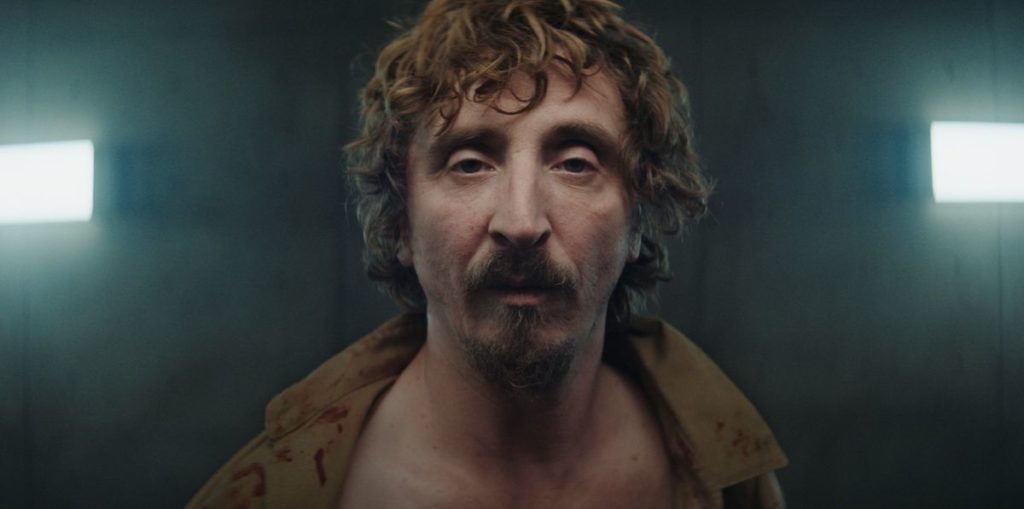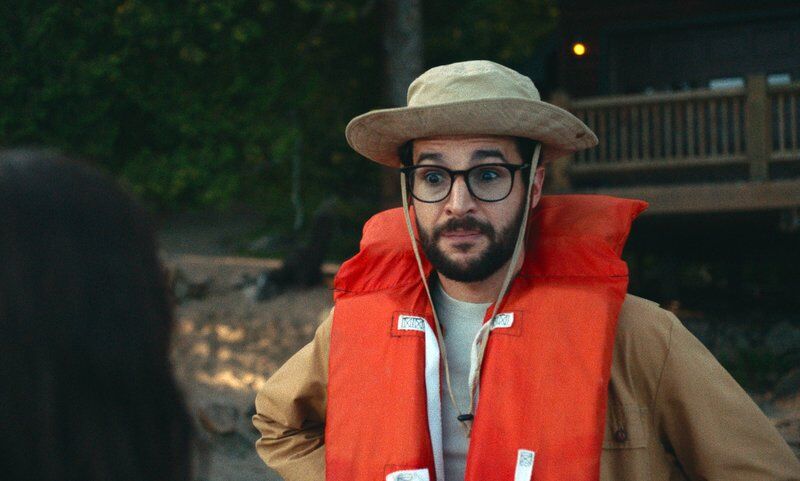You guys blew me up 2 or 3 days ago when The Platform released! Twitter DM’s, furtive emails, THiNC. recommendations, the works. So a shout out to Mir, Pancake, Frederic, William and Maria! Thanks for bringing this one to my attention. The Platform, or El Hoyo (ACK it’s in SPANISH?!?), is a movie crafted by the director Galder Gaztelu-Urrutia. And it is a mindjob to end all mindjobs… So, OK. Here we go: Netflix Movie The Platform Dissected and Explained.
Well, what is it? Hrmmm. Hard to explain. It would appear, that in the future, society has created a vertical jail of sorts called “The Pit.” And in this tower, the food for all the levels is placed on a platform the descends a level at a time. And as the platform moves its way into the bowels of tower, the occupants eat as much as they’d like, causing issues for the people further down. Obviously, this could be a fair system, if only the occupants of the tower were to take a sensible amount of food. Dot dot dot.
Alright, let me get out my copious notes…hold on a second. OK. Let’s do this – oh, wait. Please do not continue further down the page if you haven’t seen this movie. Just don’t. It’ll make my heart sad. And you’ll find your passage to this site barred when you come back. Trust me, you don’t want that.
The Rules of The Platform
- There is one platform of food for the facility
- The platform contains enough food for everyone
- The platform only stops on each floor for a few minutes per day
- Each level contains two inmates
- Each inmate can bring one luxury item
- If food is kept after the platform leaves, the heat will rise or fall until the occupants die
- If the platform comes to a floor without inmates, it doesn’t stop
- Each month, every inmate switches floors randomly
Goreng, our intrepid hero, heads to the offices of The Pit to sign up for a voluntary stay. In return for a six month stay, he will receive an advanced degree (and, oh boy will he receive an advanced degree, wow.) But generally, most people that come to The Pit are paying society for crimes that they have committed. At least, that is what I assumed the film was inferring.
As the movie starts, Goreng wakes to meet his floor-mate, Trimagasi. Trimagasi is a Pit veteran. He’s been on floor 72, 26, 43, 78, 11, 79, 32, 8 and his previous month was 132. Trimagasi introduces our naive Goreng to the rules of the system and the social hierarchies involved. Goreng had innocently assumed he could break his habit of smoking, as well as finish Don Quixote, a book he hasn’t seemed to be able to complete before. In a word, Goreng thought this would be a rehab, of sorts. A place that would allow him to improve. And afterwards, he’d have his degree, be absent his smoking habit, and have Quixote under his belt. (Talk about Quixotic!) His floor buddy on the other hand tells the story of his personal item…which happens to be the The Samurai Max. Trimagasi kept seeing ads for knives that were sharp, and easy to sharpen. Maybe his life was horrible because he didn’t have sharp knives? So, he purchased them, and then came the Samurai Max which sharpened themselves while he used them! He was so frustrated, he threw his TV out his window. And, in so doing, he accidentally killed an “illegal” walking on the street below. “Was it my fault I killed this guy? He shouldn’t have been there. They gave me a choice between The Pit and a psychiatric hospital.”
One day, Miharu rides the platform down, apparently she’s looking for her young daughter. Every month for her is the same. She kills her level-mate, and then rides her platform down to the bottom in search of her daughter. And as she continues on, she’s attacked by the floor below – but eventually, wins the day, and continues downwards on her journey.
Goreng: “Do you believe in God?”
Trimagasi: “This month, yeah, I believe in God.”
The Platform: Let’s Take Stock
So the setup and the layout of this movie is formed. We know we’ll be change levels…and, obviously, we will go up and we’ll go way down, as we learn how the different layers of our society (I mean The Pit, sorry…slip of the tongue) waste, and want. But is this a story about food conservation? I mean, literally that is what this film is about. But is that the message that it is pushing? I actually don’t think so. There is something more going on here than just a morality tale about sending your leftovers to the third world. But what?
Well, we hear that the top levels readily commit suicide. Why? Because they have plenty of “food” but nothing to look forward to. We hear stories about societal change and thinking holistically about everyone. Is it about socialism, or communism? Maybe it’s a political manifesto that would make Stalin or Marx proud. No, it’s not a political manifesto either, though, I’m sure you could make it one easily enough. Keep thinking about that though, what is this story’s larger message? Food, Stuff, Position, Power, Change, Politics, Revolution…it has to be something of note.
The Platform: Level 171
When Goreng wakes the next morning, he finds himself bound and tied to his bed. Apparently Trimagasi has anticipated their massive drop in social status, and has taken matters into his own hands. Goreng struggles, but finds himself unable to move no matter what he does. And then, after a week of not eating each day, Trimagasi decides he is going to have his first bite of Goreng. After taking a strip out of Goreng’s inner thigh, the platform begins lowering its empty contents to them. And on it is Miharu who saves Goreng from Trimagasi, kills him, and then flees lower again on the platform. And as Goreng suffers from his wounds and his starvation, he eventually decides he needs to at least eat some of his dead floor-mate.
The Platform: Level 33
The next month he drops into level 33, which means, food. Also, it means a new floor-mate since he ate his last one. And it is Imoguiri, who happens to be the same woman who was his registrar. She’s the woman that received his application, and evaluated his desire to enter The Pit. She’d been working for the administration for eight years before she decided to go herself. Her luxury item was her little pet dog. Once she sees it herself, she is horribly ashamed of what she had been doing. But she was determined to come and help, to convince the individuals in The Pit only to eat a limited allotment, thus ensuring survival for everyone at The Pit. Her plan, was to create a plate of food for each person in the level below. And for them to create plates for the level below them. And thereby, guaranteeing enough food. She wanted to create “spontaneous solidarity” from the inside out. One day, Miharu, rides the platform down and eats Imoguiri’s dog. Yeah, that’s the kind of movie this is. Normally, with any sane film, the number one rule is that you don’t kill the pet animals of the film. It just isn’t done. But not only is it killed, but eaten. Well, it turns out Imoguiri has cancer, and she’s beyond caring about anything anymore.
The Platform: Level 202
Yeah. This is bad. Originally we were told by Trimagasi that there were 200 levels. But now we are on floor 202?? And Imoguiri is already dead when Goreng wakes the first morning. Now Goreng has Imoguiri as well as Trimagasi firmly embedded in his head, constantly talking to him. Imoguiri is actually telling Goreng that he is The Pit’s Messiah…the Messiah of Crap. Goreng, through Imoguiri’s voice, is convincing himself he needs to eat her to survive. “Unless you eat my body, and drink my blood, you cannot have eternal life.” (Which, is an interesting passage of scripture. Because when Jesus originally said it, He was just as controversial as this film is. It blew the disciples’ and his follower’s minds. Many actually stopped following Him after He said it. They just couldn’t grok it. We’ll talk more about this later.)
The Platform: Level 6
When Goreng wakes at the turn of the new month, he’s greeted with a new level-mate, and his name is Baharat. And Baharat has brought as his personal item, a long run of rope. And he’s heard from God, and he’s told him that he needs Baharat to climb his way out of The Pit. Well, when Baharat attempts to climb his way up, utilizing the help of the layer above, they crap on him. The fact that Baharat is black, and the couple that live on the layer above is white, basically guarantees that we need to reevaluate everything we’ve seen up to this point through a racial vantage. How much of The Pit is racist? How much of what we’ve seen is society’s racism by even who they’ve put in here? Yeah. Personally, that was a rough encounter that really made me rethink what was happening here from top to bottom.
Now that Goreng is on level 6, he tells Baharat that he attempted to count how many levels there were. By counting the average time per floor, and when the platform returns to the top, he figured there were something like 250 levels. Goreng figures the two of them can head downwards on the platform and force people not to eat more than their fair share. And that they’d do that by not allowing the top fifty to eat anything at all.
“Only a lunatic leaves 6.”
“Or two lunatics on fire.”
The two do just that. On the way down, they do pretty well keeping the people off the food. Then on one floor, they come across a wise man, Sr. Brambang, and he tells them they should send a message back to level zero. And they decide that the Panna Cotta will be their message – that they will send this untouched desert all the way back to the surface, and it will cause a revolution of change. So the two men protect the Panna Cotta as they go.
They come across a level wherein two men are viciously attacking Miharu. Stabbing her to death even. Goreng and Baharat jump into the fray. Baharat catches a Katana to his gut, and Goreng is repeatedly beaten senseless and bloody. Somehow though, the two continue their progress down. And after they get to fifty, they begin handing food out, and things get easier. And when the dynamic duo make it to 333, they are confused. But it’s because they have found where Miharu’s daughter has been hiding.
The Panna Cotta & The Girl
But, because all the food is gone, the two men have a decision to make. The Panna Cotta remains, but it was going to be the message that would get the administration to take notice. Goreng finally convinces Baharat to let the Panna Cotta go. And the young girl consumes it whole. But what is their message going to be? They need to think of something that will convince the people running The Pit of the horrors committed here, and to change. And that is when Goreng comes up with the idea that the girl will be the message.
The Ending of The Platform Explained
Wait, what? The insanity that is The Platform is really hard to reconcile. Obviously there are parallels to society today. The have and the have-nots. Food inequalities. Power disparities. Political chaos and turmoil that exacerbates inequalities. There are racial injustices and fault lines that have long divided our world. But what could this movie really be about? Why don’t we walk through a couple of different explanations in order to kinda think through some of the ways this movie could be interpreted.
The Tragedy of the Commons
But before we do, we have to discuss a simple economic concept called, The Tragedy of the Commons which is a concept that comes into play when a system is driven by shared resources. All others will independently work to maximize their own self interest, and will actively disregard the overall common good. Wait, what? OK, look – if you have ten sheep, and I have ten sheep, and we have chosen to share our backyards to take care of them, we have a problem. Why? Because I will do absolutely everything I can to get my sheep as much of the grass as I can. Worse, I will even go so far as ruin the grass entirely, I will let my sheep eat the grass into oblivion as opposed to caring for the grass in both our yards. And worse, you are going to do your very best to get yours, which perpetuates the problem. This movie is a field study into the reality of the Tragedy of the Commons and human nature. The only way for this problem to be solved is through someone breaking the cycle of selfishness. OK, now that we understand that, let’s walk through a couple possible explanations.
Explanation 1 – Food-ness
One way to look at this movie is solely through the lens of food. The movie is casting a light on those that have food, and those that don’t. It is literally taking this platform, of food, and showing the problems that our capitalistic, world economy is doing to the least of these. It’s intended as a spotlight on the most unfortunate among us. Yeah, well, that’s one way of looking at it, but I think if you are guessing that this is the movie’s goal, you probably got pretty bored with the movie really fast. YES, I KNOW, my MOM says I need to eat my green beans for this very reason! There’s a starving kid in Africa somewhere!! Yeah, I just don’t buy this as a real explanation. I mean, sure. This is obviously there. But I don’t think it’s the main point the movie is making. I mean, maybe?
Explanation 2 – Politicalism
OK, if it’s bigger than food, and the point needs to be broader, what about politics? Could it be that the movie is pushing against the west’s capitalist agenda? Maybe it is saying that through a more compassionate approach, a more socialist position, we could care for people and their more dire needs. I mean, is it too hard to expect that everyone would be fed, and everyone would be cared for in a modern society? Politics does deal with the problem of constrained resources. That is really what politics are for. But did you notice when, in the beginning, Goreng tells the people below that they should ration the food for the people below? Trimagasi asks Goreng, “What are you, a Communist?” Even those individuals that are going without in this film make fun of socialism. So it just doesn’t seem like that is what is happening here. Narrow. Seems too narrow.
Explanation 3 – Power Strata
Is Netflix’s movie saying something about the power strata in our daily lives. Those that have and those that do not? Could it be that maybe the movie is commenting on the natural way in which society clumps into hierarchies and these hierarchies naturally look down on those that are below us? This seems feasible in that we literally can see these social structures literally look down on each other. But the flaw in this theory is that these structures are built up, and torn down again each month. So, there isn’t much in the way of permanence in these structures. Or maybe that is the point. Given a chance to be a level six, there is little chance that you’ll be giving up your position to a level seven idiot. Hrm. I don’t know.
Explanation 4 – Spiritualism
Of all the references that are in the actual script that support one theory over another, it’s within the world of spiritualism. I mean, even before Goreng gets but maybe a month or two in he’s referred to as a Messiah. Then later on, when his dead level-mates are talking to him about eating Imoguiri, we have Bible verse after Bible verse quoted (obviously taken out of context). Then, as Goreng and Baharat are heading down the platform, the people being kept from eating are asking whether or not they are the Messiah, and didn’t the Messiah multiply food, not withhold it? No, it isn’t purely about spiritualism, but I do think we are actually getting closer now.
Explanation 5 – Ethics and Duty
Goodness. Basic goodness. Where was the goodness in this movie? Hrm. There wasn’t much of it at all. Maybe Miharu? The cannibal. She was good to our Goreng. Saved his life even. But where else? Goreng attempted to be good on occasion, but failed repeatedly. It was a recurring theme throughout the entire film.
There’s a field of Philosophy called Deontological Ethics, founded by Immanuel Kant, which places special emphasis on the relationship between duty and the morality of human actions. Kant said that we must act out of duty, and that our motives in these actions define the rightness and wrongness of these actions. So, I am on level 12, and I forgo eating anything from the platform…this is a moral good. Because people below level 12 will now be able to eat. But, if my reason for not eating was that I was dieting? Yeah, not so much. But throughout this film, there was nearly zero effort from any of the characters to do the right thing. To help others. To be good.
The entirety of The Pit is defined by hundreds of individuals driven completely by self interest. Totally. When am I going to get mine? And when I do, how can I maximize mine, even at the expense of yours? There is literally no one deontologicaling here.
But Which Is It?
This is a dark, dark movie. It is a metaphor, or maybe an allegory, telling the story of human life on earth. All of it. Think about it, global over-fishing… tragedy of the commons. Global food crisis… tragedy of the commons. Global warming… tragedy of the commons. When humans are unregulated, and unchecked, they will do anything and everything to maximize theirs. The only way to solve this problem is to find a savior. (There actually are thinkers out there (like Elinor Ostrom) who have solved the Tragedy of the Commons, but they almost exclusively assume collectives, or state actions. But that is beside the point here.)
And yes, our Christ-like savior figure in this movie is Goreng. He came to The Pit with the hopes of blissfully spending his six months there and then earning his degree. But when he realizes what is really going on here, he has to do something. He has to change. And he needs to do something in order to break the cycle for everyone else. And even though we are well over 3,000 words so far, there’s one last thing we have GOT to talk about. And that is Miguel de Cervantes’ novel, Don Quixote.
Don Quixote and The Platform
I’ve always said, when watching movies, if a book is introduced, even if it’s just sitting on the counter, it is important. If you are lost for what is happening in a movie, head to the library, and check the books out and flip through them. The only real cultural reference given throughout the course of this movie is, as I’ve mentioned, Don Quixote. In 2015, Cervantes’ novel, Don Quixote, turned 400. FOUR HUNDRED! And regularly, Don Quixote finds itself being voted as the best book of all time. OF ALL TIME. It is a really important book. Trust me on this. It’s big. It’s big because Cervantes himself has said that his goal in writing the book is to undermine the influence of the chivalric books of the day. And he did that while making his readers laugh with some really funny entertainment.
Don Quixote is a novel about a man at the age of fifty who has completely run out of ideas or motivation to move on any further. And so he decides, he will just read his way to the end of his life. And our hero dines exclusively on a diet of romantic novels regaling the reader with heroes and chivalry. And poof, while reading one of these novels, his mind goes crazy, and he thinks he is one of these heroes in the novels he’s been reading. From this moment forward, Quixote is living on a different plane of reality. You know, the reality that makes Don tilt at fake monsters that are really just windmills. But it justifies his existence, it justifies the rest of Quixote’s life.

I mean, look at this photo of Cervantes – and consider what Goreng looks like! Here – I will help remind you!!

Come on! This isn’t accidental. This is all on purpose. It is important in helping us understand what is going on here.
My Final Thoughts on The Platform
I believe that this movie is a modern day Don Quixote. Goreng wakes up, in the middle of his life, and decides, I am going to spend the rest of my life, reading books. And he believes that The Pit is a great place to finish this book he’s always wanted to read. And in the middle of his reading, he wakes up, and realizes he would spend the rest of his life tilting at windmills. He was going to do something incredibly stupid. And that was, he was going to send a message to the administration. He didn’t know what that message would be – but he was going to send a message. At first it was the Panna Cotta. Then he realizes that the right message to send would be the girl that they find down at level 333.
Goreng is our modernist Christ figure, intent on turning the tables in the courtyard. He’s going to do this insane, flawed, and utterly futile thing! Do I think sending the girl up to level zero will change anything? No. I don’t. And we are even told it won’t work through the movie’s references back to Don Quixote. He is going to die in making this play. And yet we know it will ultimately do nothing to change the make up of how The Pit will work. It is a Quixotic tilting at windmills. Alright, I’m done talking. Now, what do you think? What do you think this crazy movie is all about?
If you’d like to find other crazy closed box movies that are extraordinarily well written, tight, and worth watching…you might want to consider: We’ve Forgotten More Than We Ever Knew, The Exam, and Faults.
Edited by: CY




